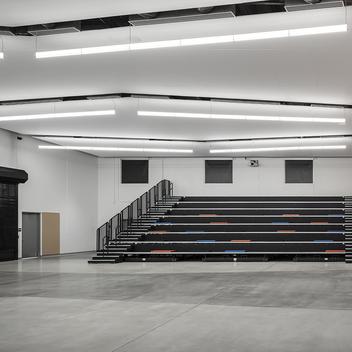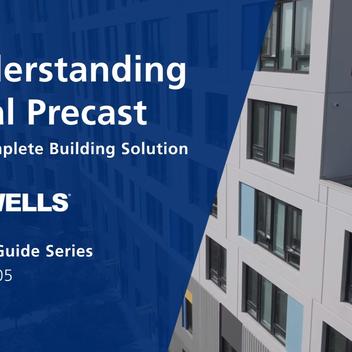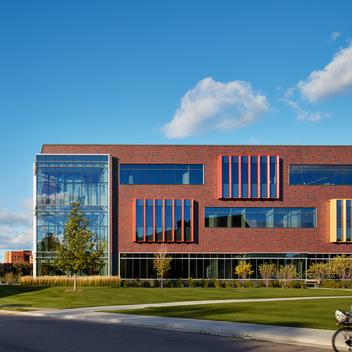
Design possibilities are virtually limitless today with the use of prefabricated building systems. Architects are now able to broaden their design palette in ways that would have been unfathomable a few years ago, largely due to an ever-expanding array of tools, materials and technologies now available to manufacturers.
Architectural Finishes
Whether it is for the building’s interior or exterior finish, prefabricators are helping designers tap into an exhaustive array of colors by blending cements, pigments and aggregates, as well as incorporating a variety of textures, reveals and sculpted features with the help of formliners and veneers.
What materials can precast emulate?
Essentially, there are very few construction materials that a prefabricated system can’t emulate. Formliners can replicate or create limitless patterns or imprinted designs, which can be both geometric or organic in appearance. Formliners can also help integrate embedded materials such as tile, thin brick, acrylic veneers, terra cotta, or stone veneers, while also allowing for greater dimension and depth in surfaces for bullnoses, reveals, cornices and dentils.
In addition, there are a variety of finish techniques that can be used to support an architect’s design vision. Some of the more common are:
- Burnished, for a metallic effect
- Polished, for a smooth reflective surface
- Terrazzo, whereby aggregate is ground and polished to emulate a terrazzo-like finish
- Oldstone, to provide the look of natural stone to match classical architectural styles
- Travertine, to create a natural, textured look
- Sandblasted, to create an exposed, textured appearance
- Waterwash, to accentuate the exposed aggregate in the panel
- Acid Etch, to create a sparkle effect and refined finish
Creative Design of Architectural Precast
Because of recent advancements, using a combination of finishes and colors is becoming the norm on projects. Whether it is for manufacturing, multi-family, education, office or healthcare, designers are leveraging the variety of finishes to enhance their community’s aesthetic. Here are a few examples of how this is being done.

At SICK Manufacturing in Bloomington, MN, for example, a variety of multi-colored panels were created to support the expansion and consolidation of the company’s North American operations. The charcoal-colored monolithic design utilizes six patterns, with a variety of polished concrete, sandblast and acid etched finishes randomly placed in different locations, creating a stunning, unique exterior.

In Chicago, the seven-story, 100-unit, multi-family Lucy Gonzalez Parsons Apartments features faceted prefabricated panels with custom stained coloring that reflects the developer, Bickerdike’s branding. The lower exterior levels incorporate a darker stain and formliner to successfully mimic shiplap siding to add visual dimension. At the street-facing corner entrance of the building, prefabricated panels support a cantilevered edge, allowing for unobstructed corner window views.

At The International Institute of Minnesota, a St. Paul-based charitable organization, prefabrication matched the existing white-brick building by incorporating white concrete into the exterior panels that also feature intricate imprinted detailing, using a pattern of black sand and aggregate, helping bring the project to life.

At the Swedish Medical Center Parking Garage in Denver, gray acid-etched spandrels combined with cast-in Concrete Masonry Unit (CMU) and thin brick provide a pleasing aesthetic to complement the healthcare campus and the traditional aesthetic of the community’s longest support system.

To create architectural variety, two mix colors and three finishes – thin brick in a stack bond, polished white and dark charcoal acid etched concrete – were incorporated to add variety into the design at the two-story Austin Community Recreation Center. The final design utilizes multiple architectural and structural prefabricated products, including insulated walls, double tees, hollow core plank, and structural solid walls.

With requirements to provide a high-end façade to blend the garage into the surrounding historic downtown architecture, the Glen Ellyn Civic Center Parking Structure utilized architectural prefabricated wall panels with thin-set brick and dramatic cornices. The wall panels served double duty as both the architectural façade and the bearing wall system.

At Starz Encore, the design team effectively simulated the granite cladding of the existing building for a new office facility by using a custom concrete mix with a formliner. In the process, all vertical joints in the facade were concealed with concrete “soaps” to replicate a mason’s joinery.
Architectural Precast Offers Design Flexibility
Prefabricated building systems can provide the desired design flexibility for fast paced and cost-sensitive solutions for architects who are looking to push the building envelope design. To assist, Wells recently published an Architectural Inspiration Guide, to showcase the beauty and versatility of prefabricated building solutions, as well as spur creative architectural ideas.
Wells serves as a creative collaborator, delivering innovative solutions to enhance our partners ideas, from exposed concrete supporting modern office designs to sealed, USDA-compliant interior finishes. We pride ourselves in our ability to listen, and adeptly guide designers through the selection of a variety of colors, textures, features and custom exterior design options.
Our wide array of architectural finishes, custom designs and special features provide limitless combinations to bring the architects vision to reality. In the end, prefabricated systems can facilitate a unique and exceptional result for any project.



